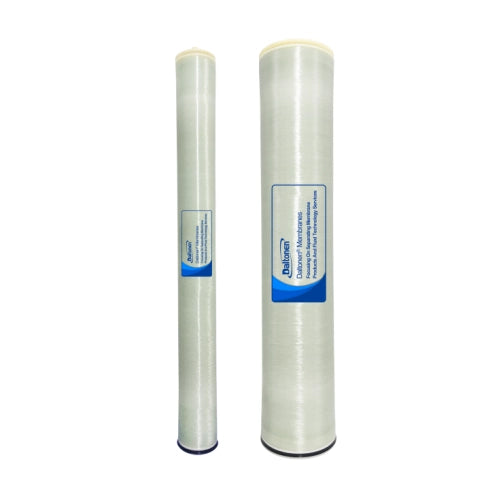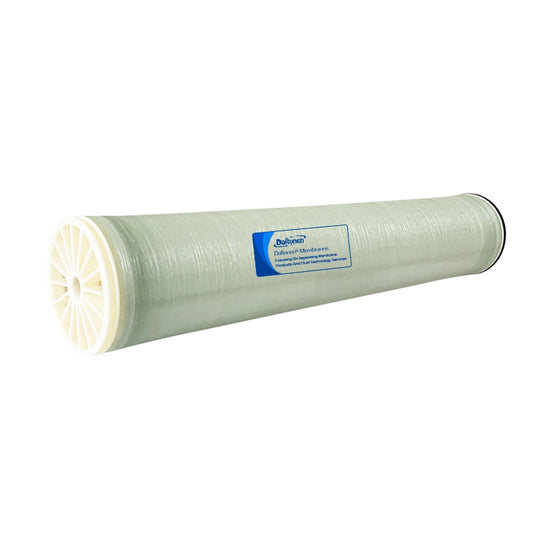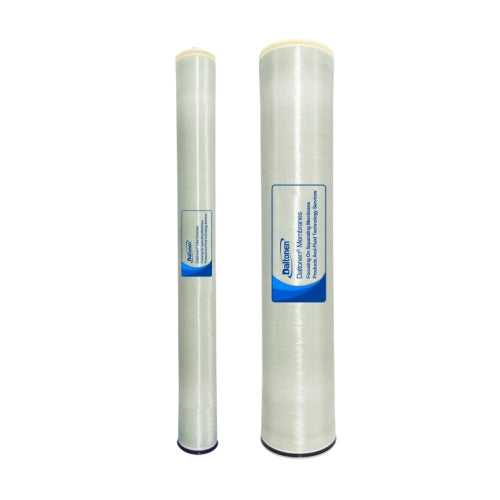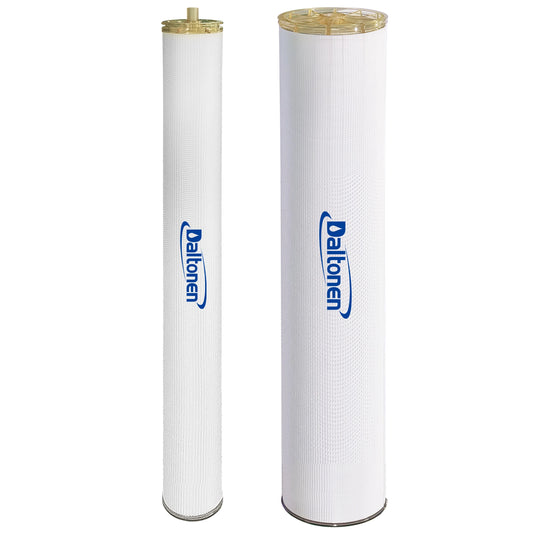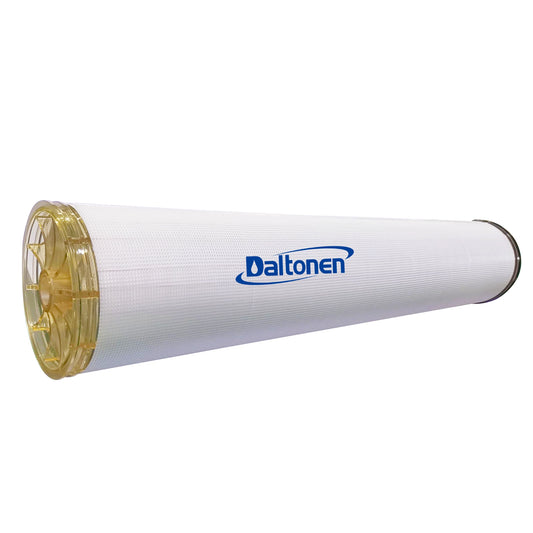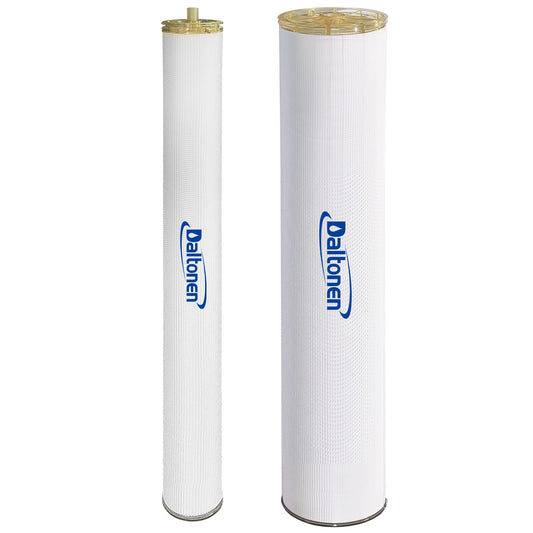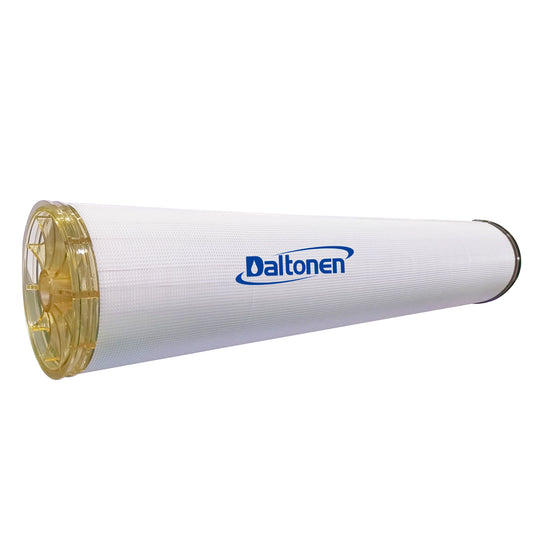What RO Membrane to Use for Circulating Water Discharge with a Total Hardness of 1000ppm?
20 May 2025
1. Overview of RO Membrane Types
1.1 Characteristics of Polyamide Composite Membranes
Polyamide composite membranes are one of the most widely used RO membrane materials, with the following significant features:
-
High Desalination Rate: Polyamide composite membranes typically achieve a desalination rate of over 99%, effectively removing calcium, magnesium, and other hardness components from circulating water. Even with a total hardness of 1000ppm, they can reduce the hardness to extremely low levels.
-
Good Pressure Resistance: These membranes generally have a pressure resistance of above 1.5MPa, ensuring stable operation in high-flow and high-concentration circulating water treatment processes.
-
High Chemical Stability: Polyamide composite membranes have a broad pH tolerance, usually maintaining good performance between pH 2 and 11, and can adapt to the common acidic and alkaline environments found in circulating water discharge.
-
Strong Anti-fouling Performance: The surface of these membranes is specially treated to have low surface energy, effectively reducing the adhesion of inorganic salt scale and organic matter, extending the membrane's service life.
-
Application Case: In a large-scale industrial circulating water treatment project, polyamide composite membranes were used to treat circulating water with a total hardness of 1000ppm. After one year of operation, the membrane's performance remained stable, with the effluent hardness consistently below 10ppm, and the system's recovery rate reached over 75%, demonstrating good treatment effectiveness and economic benefits.

1.2 Characteristics of Aromatic Polyamide Membranes
Aromatic polyamide membranes are a type of polyamide composite membrane with unique structure and performance:
-
High Selectivity: Aromatic polyamide membranes have uniform and small pore size distribution, typically between 0.1 and 1nm, which can efficiently intercept divalent ions such as calcium and magnesium in water. For circulating water with a total hardness of 1000ppm, the hardness removal rate can reach over 99.5%.
-
High Water Flux: The water flux of these membranes generally ranges from 15 to 30L/m²·h, which is 20% to 30% higher than that of ordinary RO membranes. When treating high-hardness circulating water, they can achieve higher water production efficiency at lower operating pressures.
-
Chemical Cleaning Resistance: Aromatic polyamide membranes can withstand frequent chemical cleaning, with a membrane performance recovery rate of over 95% after cleaning. This allows them to maintain good operating conditions through regular cleaning when treating circulating water containing a large amount of organic matter and microorganisms.
-
Strong Durability: The service life of these membranes can generally reach 3 to 5 years, which is 1 to 2 years longer than that of ordinary RO membranes. They can maintain stable performance in long-term operation, reducing the cost of membrane replacement.
-
Practical Application Data: In a chemical company's circulating water treatment system, aromatic polyamide membranes were used to treat circulating water with a total hardness of 1000ppm. After continuous operation for two years, the average desalination rate of the membranes remained above 99.3%, the system's average recovery rate reached 78%, and only 4 to 5 chemical cleanings were required per year, demonstrating good durability and economic benefits.
1.3 Characteristics of Thin Film Composite Membranes
Thin film composite membranes are a new type of RO membrane material with the following features:
-
High-efficiency Separation Performance: The separation layer of thin film composite membranes is very thin, usually only tens of nanometers thick, but it has extremely high separation efficiency. For circulating water with a total hardness of 1000ppm, the hardness removal rate can reach over 99.8%, effectively reducing the hardness of circulating water and improving water quality.
-
Low Energy Consumption: The operating pressure of these membranes generally ranges from 0.5 to 1.0MPa, which is 20% to 30% lower than that of traditional RO membranes. When treating high-hardness circulating water, they can significantly reduce energy consumption and operating costs.
-
Strong Anti-fouling Capability: The surface of thin film composite membranes is specially modified to have good hydrophilicity and anti-fouling performance, effectively reducing the adhesion of pollutants and extending the membrane's service life. When treating circulating water containing a large amount of suspended solids and organic matter, their anti-fouling performance is 30% to 40% better than that of ordinary RO membranes.
-
Quick Start-up and Recovery: Thin film composite membranes can quickly recover their performance after shutdown, with a start-up time generally within 12 hours, which is more than 50% shorter than that of traditional RO membranes. This gives them a clear advantage in intermittent circulating water treatment systems.
-
Case Analysis: In an electronic factory's circulating water treatment system, thin film composite membranes were used to treat circulating water with a total hardness of 1000ppm. After half a year of operation, the average desalination rate of the membranes remained above 99.7%, the system's average energy consumption was reduced by 25% compared to traditional RO membranes, and after a one-week shutdown, the membrane's performance recovery rate reached over 98%, demonstrating good quick start-up and recovery capabilities.
2. Characteristics of Water with a Total Hardness of 1000ppm
2.1 Analysis of Hardness Components
Water with a total hardness of 1000ppm mainly consists of calcium and magnesium ions, with calcium ions typically accounting for 60% to 70% of the total hardness and magnesium ions for 30% to 40%. Additionally, there may be small amounts of other divalent metal ions such as iron and manganese ions. For example, in an industrial circulating water with a total hardness of 1000ppm, the calcium ion concentration was 620ppm, the magnesium ion concentration was 350ppm, the iron ion concentration was 10ppm, and the manganese ion concentration was 20ppm. The presence of these hardness components can significantly impact the performance of RO membranes.
2.2 Potential Impact on Membranes
-
Scaling Risk: Calcium and magnesium ions in water tend to form precipitates such as calcium carbonate and magnesium hydroxide, which adhere to the surface of RO membranes, forming a scale layer. This scale layer can block membrane pores, increase membrane resistance, and reduce the membrane's water flux and desalination rate. For example, after operating for a period in an RO system with water having a total hardness of 1000ppm, if no effective anti-scaling measures are taken, the membrane's water flux may decrease by 30% to 50%, and the desalination rate may drop by 5% to 10%.
-
Chemical Corrosion: Some hardness components, such as iron and manganese ions, can chemically corrode the membrane material. Iron ions, when oxidized in water, form iron oxides that adhere to the membrane surface, not only blocking membrane pores but also causing mechanical wear and chemical corrosion of the membrane material. Manganese ions cause similar problems after oxidation. Studies have shown that when the iron ion concentration exceeds 5ppm, the membrane's service life may be shortened by 20% to 30%.
-
Microbial Growth: Water with high total hardness often contains a large amount of organic matter and nutrients, which can easily lead to microbial growth. Microbes proliferate on the membrane surface, forming biofilms. Biofilms not only block membrane pores but also secrete organic substances, further exacerbating membrane fouling. The formation of biofilms can reduce the membrane's water flux by 20% to 40%, and they are difficult to remove with conventional cleaning methods.
-
Physical Plugging: Water with a total hardness of 1000ppm may contain a certain amount of suspended solids and colloidal particles, which can enter the RO system with the water flow and cause physical plugging on the membrane surface. The particle size of suspended solids and colloidal particles is usually between 1 and 100μm, and they can block the membrane's feed water channels, increasing the membrane's operating pressure and reducing its performance. In practice, when the suspended solids concentration in water exceeds 5mg/L, the membrane's operating pressure will significantly increase, and the rate of water flux decline will accelerate.

3. Selection Criteria for RO Membranes Suitable for Water with a Total Hardness of 1000ppm
3.1 Anti-fouling Performance Requirements
When treating circulating water with a total hardness of 1000ppm, the anti-fouling performance of RO membranes is crucial. Research data shows that water with a total hardness of 1000ppm contains a large amount of calcium and magnesium ions, which easily form scale layers. Additionally, the water may contain suspended solids, colloidal particles, organic matter, and microorganisms, all of which can exacerbate membrane fouling. Therefore, RO membranes need to have the following anti-fouling performance:
-
Anti-inorganic Scale Capability: The membrane surface should have low surface energy to reduce the adhesion of scale layers formed by calcium and magnesium ions. For example, after special treatment, polyamide composite membranes have lower surface energy, effectively reducing the adhesion of inorganic salt scale and extending the membrane's service life. In practical applications, when treating circulating water with a total hardness of 1000ppm, polyamide composite membranes can maintain stable performance for one year, with the effluent hardness consistently below 10ppm.
-
Anti-organic Fouling Capability: Water with a total hardness of 1000ppm may contain organic matter that can adhere to the membrane surface, forming an organic fouling layer. Thin film composite membranes, with their specially modified surfaces, have good hydrophilicity and anti-fouling performance, effectively reducing the adhesion of organic matter. When treating circulating water containing a large amount of organic matter, their anti-fouling performance is 30% to 40% better than that of ordinary RO membranes.
-
Anti-microbial Fouling Capability: The water contains a large amount of organic matter and nutrients, which can easily lead to microbial growth and biofilm formation. Aromatic polyamide membranes can withstand frequent chemical cleaning, with a membrane performance recovery rate of over 95% after cleaning. This allows them to maintain good operating conditions through regular cleaning when treating circulating water containing a large number of microorganisms.
3.2 Desalination Rate Requirements
Water with a total hardness of 1000ppm needs to effectively remove calcium and magnesium ions through RO membranes to reduce water hardness. Therefore, the desalination rate of RO membranes is a key indicator for selection:
-
High Desalination Rate: The desalination rate of RO membranes should reach over 99% to ensure effective removal of hardness components in circulating water. Polyamide composite membranes typically achieve a desalination rate of over 99%, which can significantly reduce the hardness of water with a total hardness of 1000ppm.
-
High Selectivity: For water with a total hardness of 1000ppm, RO membranes need to have high selectivity to efficiently intercept divalent ions in water. Aromatic polyamide membranes have uniform and small pore size distribution, typically between 0.1 and 1nm, which can efficiently intercept calcium and magnesium ions in water, with a hardness removal rate of over 99.5%.
-
Long-term Stability: In long-term operation, the desalination rate of RO membranes should remain stable. Thin film composite membranes, when treating circulating water with a total hardness of 1000ppm, maintain an average desalination rate of over 99.7% after half a year of operation, demonstrating good long-term stability.
3.3 Mechanical Strength Requirements
When treating circulating water with a total hardness of 1000ppm, RO membranes need to withstand high operating pressures and water flow impacts. Therefore, mechanical strength is an important selection criterion:
-
Pressure Resistance: The pressure resistance of RO membranes should reach above 1.5MPa to ensure stable operation in high-flow and high-concentration circulating water treatment processes. Polyamide composite membranes generally have a pressure resistance of above 1.5MPa, meeting the requirements for treating circulating water with a total hardness of 1000ppm.
-
Impact Resistance: In actual operation, RO membranes may be subject to mechanical stresses such as water flow impacts. Thin film composite membranes have an operating pressure generally between 0.5 and 1.0MPa, which is 20% to 30% lower than that of traditional RO membranes. When treating high-hardness circulating water, they can significantly reduce energy consumption while also reducing mechanical stress damage to the membrane.
-
Durability: The service life of RO membranes should reach 3 to 5 years to reduce the cost of membrane replacement. Aromatic polyamide membranes generally have a service life of 3 to 5 years, which is 1 to 2 years longer than that of ordinary RO membranes, and can maintain stable performance in long-term operation.
4. Common Applicable RO Membrane Brands and Model Recommendations
4.1 Applicable Models of DuPont Filmtec Series
The DuPont Filmtec series of RO membranes are high-performance membrane products widely used in the market, with various models suitable for treating circulating water with a total hardness of 1000ppm.
-
Filmtec™ SW30HRLE400/34i Model: This membrane element features high desalination rate and high water flux. It achieves a desalination rate of up to 99.8%, effectively removing calcium, magnesium, and other hardness components from circulating water. When treating water with a total hardness of 1000ppm, its water flux can reach 20L/m²·h, and it maintains stable performance even under high-salinity feed water conditions. Additionally, this membrane element has a pressure resistance of 1.5MPa, making it suitable for high-flow and high-concentration circulating water treatment systems.
-
Filmtec™ SW30XLE400/34i Model: This membrane element is designed for high-salinity and high-hardness water quality and features excellent anti-fouling performance. Its surface is specially modified to effectively reduce the adhesion of inorganic salt scale and organic matter, extending the membrane's service life. When treating circulating water with a total hardness of 1000ppm, its hardness removal rate can reach 99.7%, and after continuous operation for two years, the average desalination rate of the membrane remains above 99.5%. This membrane element also has excellent chemical cleaning resistance, with a membrane performance recovery rate of up to 98% after cleaning, meeting the demand for frequent chemical cleaning.
4.2 Applicable Models of Daltonen Series
The Daltonen series of RO membranes are known for their high efficiency and reliability, with the following models suitable for treating circulating water with a total hardness of 1000ppm:
-
DA-PRO-4040 Model: This membrane element features high water flux and low energy consumption. Its water flux can reach 2050gpd/m3·day, which is 30% higher than that of ordinary RO membranes. When treating circulating water with a total hardness of 1000ppm, it can achieve higher water production efficiency at lower operating pressures. This model has a desalination rate of up to 99.7%, effectively removing hardness components from water. Additionally, it has strong anti-fouling performance, with a specially treated surface that reduces pollutant adhesion and extends the membrane's service life.
-
DLE Series Brackish Water Desalination Membrane: This membrane element performs well in high-hardness water quality treatment, with a hardness removal rate of up to 99.8%. It can significantly reduce the hardness of water with a total hardness of 1000ppm. It also has good chemical cleaning resistance, with a membrane performance recovery rate of up to 96% after cleaning, making it suitable for use in circulating water treatment systems containing a large amount of organic matter and microorganisms.
4.3 Applicable Models of Dow Series
The Dow series of RO membranes are widely used for their advanced technology and high performance, with the following models suitable for treating circulating water with a total hardness of 1000ppm:
-
BW30400 Model: This membrane element features high desalination rate and high water flux. It achieves a desalination rate of up to 99.7%, effectively removing calcium, magnesium, and other hardness components from circulating water. When treating water with a total hardness of 1000ppm, its water flux can reach 22L/m²·h, and it maintains stable performance in long-term operation. This model has a pressure resistance of 1.5MPa, meeting the requirements for high-flow and high-concentration circulating water treatment. Additionally, it has strong anti-fouling performance, with a specially treated surface that reduces the adhesion of inorganic salt scale and organic matter, extending the membrane's service life.
-
BW30365 Model: This membrane element is designed for high-hardness water quality and features efficient hardness removal and good anti-fouling performance. It achieves a hardness removal rate of up to 99.8%, significantly reducing the hardness of water with a total hardness of 1000ppm. This model has a pressure resistance of 1.5MPa, ensuring stable operation in high-flow and high-concentration circulating water treatment processes. It also has excellent chemical cleaning resistance, with a membrane performance recovery rate of up to 97% after cleaning, making it suitable for use in circulating water treatment systems containing a large amount of organic matter and microorganisms.
5. Pretreatment Requirements for RO Membranes
5.1 Hardness Pretreatment Methods
When treating circulating water with a total hardness of 1000ppm, pretreatment is a key step to ensure the efficient operation of RO membranes. The hardness components are mainly calcium and magnesium ions, which can easily form scale layers in water, blocking membrane pores and reducing membrane performance. Therefore, hardness pretreatment is crucial.
-
Ion Exchange Method: Ion exchange resins are one of the commonly used methods for hardness pretreatment. Through cation exchange resins, calcium and magnesium ions in water can be replaced with sodium ions, thereby reducing water hardness. Research shows that ion exchange resins can reduce the hardness of water with a total hardness of 1000ppm to below 10ppm. The advantage of this method is its simple operation and stable treatment effect, but it requires regular resin replacement, increasing operating costs.
-
Softening Agent Method: Using chemical softening agents, such as phosphates and polyphosphates, can chemically react with calcium and magnesium ions in water to form soluble complexes, thereby reducing water hardness. This method is cost-effective, but its treatment effect is not as stable as ion exchange, and it may introduce other chemical substances.
-
RO Pretreatment: In some cases, a two-stage RO system can be used. The first-stage RO membrane can remove most of the hardness components, reducing the water hardness to a lower level, and then the second-stage RO membrane can further treat the water to ensure that the effluent hardness meets the requirements. The advantage of this method is its good treatment effect, but the system is complex, and the investment and operating costs are high.
5.2 Pretreatment of Other Impurities
In addition to hardness components, circulating water may also contain other impurities such as suspended solids, colloidal particles, organic matter, and microorganisms. These impurities can negatively impact the performance of RO membranes and therefore also need to be pretreated.
-
Filtration Method: Using sand filtration, activated carbon filtration, or microfiltration can effectively remove suspended solids and colloidal particles from water. Sand filtration can remove particles larger than 10μm, while activated carbon filtration can not only remove suspended solids but also adsorb organic matter and odors in water. Research shows that after sand filtration and activated carbon filtration, the suspended solids concentration in circulating water can be reduced to below 1mg/L.
-
Chemical Oxidation Method: Using chemical oxidants such as chlorine, ozone, and hydrogen peroxide can oxidize organic matter and microorganisms in water, reducing their pollution to RO membranes. For example, ozone has strong oxidizing power and can effectively decompose organic matter in water, reducing chemical oxygen demand (COD). In practical applications, ozone-treated circulating water can achieve a COD removal rate of 60% to 70%.
-
pH Adjustment: Adjusting the pH value of water is also an important pretreatment step. For polyamide composite membranes, the optimal operating pH range is 6 to 8. By adding acids or bases to adjust the pH value of circulating water to the appropriate range, the performance and service life of the membrane can be improved.
6. Maintenance and Cleaning of RO Membranes
6.1 Regular Maintenance Measures
To ensure the long-term stable operation of RO membranes when treating circulating water with a total hardness of 1000ppm, regular maintenance is essential. Maintenance measures mainly include the following aspects:
-
Monitoring Water Quality Parameters: Regularly monitor the hardness, pH value, turbidity, chemical oxygen demand (COD), and other parameters of the feed water to promptly detect changes in water quality and adjust pretreatment and operating parameters accordingly. For example, if the feed water hardness exceeds 1000ppm, the normal operation of the pretreatment system should be checked immediately.
-
Checking Membrane Element Performance: Regularly test the desalination rate, water flux, and other performance indicators of membrane elements. If the desalination rate decreases by more than 5% or the water flux decreases by more than 10%, cleaning or replacing the membrane elements may be necessary.
-
Inspecting System Components: Check whether the pressure vessels, pipes, valves, pumps, and other components of the RO system are operating normally and look for any leaks or blockages. For example, the sealing performance of pressure vessels is crucial for the operation of membrane elements, and any leaks should be repaired immediately.
-
Maintaining Pretreatment Systems: Regularly maintain pretreatment systems, such as replacing filter cartridges and regenerating ion exchange resins. For sand filters, backwashing should be performed every 3 to 6 months; for activated carbon filters, the activated carbon should be replaced every 12 months.
6.2 Cleaning Methods and Frequency
Cleaning is an important means of restoring the performance of RO membranes, and the cleaning methods and frequency should be determined based on the type and degree of membrane fouling.
-
Physical Cleaning: Physical cleaning mainly involves backwashing with water to remove pollutants from the membrane surface. This method is suitable for mild membrane fouling, such as the adhesion of suspended solids and colloidal particles. The frequency of backwashing is generally 1 to 2 times per week, and the specific frequency should be adjusted according to the actual operating conditions.
-
Chemical Cleaning: Chemical cleaning involves using chemical agents to remove pollutants from the membrane surface, such as inorganic scale, organic matter, and microorganisms. For circulating water with a total hardness of 1000ppm, the frequency of chemical cleaning is generally 1 to 2 times per month. Commonly used chemical cleaning agents include:
-
Acidic Cleaning Agents: Used to remove inorganic scale, such as calcium carbonate and magnesium hydroxide. Common acidic cleaning agents include hydrochloric acid and citric acid. During the cleaning process, the pH value of the cleaning solution should be controlled between 2 and 3, and the cleaning time should be 30 to 60 minutes.
-
Alkaline Cleaning Agents: Used to remove organic matter and microorganisms. Common alkaline cleaning agents include sodium hydroxide and sodium carbonate. The pH value of the cleaning solution is generally controlled between 10 and 12, and the cleaning time is 30 to 60 minutes.
-
Oxidizing Agent Cleaning Agents: Used to remove microorganisms and some organic matter. Common oxidizing agent cleaning agents include sodium hypochlorite and hydrogen peroxide. During the cleaning process, the oxidation-reduction potential (ORP) of the cleaning solution should be controlled within a certain range to avoid damaging the membrane material.
-
-
Cleaning Effect Assessment: After cleaning, the cleaning effect should be assessed, mainly by testing the desalination rate, water flux, and other performance indicators of the membrane elements to determine whether the cleaning is effective. If the membrane's performance is restored to more than 90% of its pre-cleaning level after cleaning, the cleaning effect is considered good. If the cleaning effect is not satisfactory, the reasons should be analyzed, and the cleaning method or chemical formula should be adjusted.
7. Summary
When treating circulating water with a total hardness of 1000ppm, selecting the appropriate RO membrane is crucial. Based on the analysis of the characteristics of different RO membrane types, combined with the characteristics of water with a total hardness of 1000ppm and the requirements for membrane performance, the following conclusions can be drawn:
Polyamide composite membranes, aromatic polyamide membranes, and thin film composite membranes are all suitable for treating circulating water with a total hardness of 1000ppm. Polyamide composite membranes have high desalination rates, good pressure resistance, high chemical stability, and strong anti-fouling performance. Their practical application demonstrates good stability and economic benefits. Aromatic polyamide membranes have advantages such as high selectivity, high water flux, chemical cleaning resistance, and strong durability. They can efficiently remove hardness components from water and maintain stable performance in long-term operation. Thin film composite membranes, with their high-efficiency separation performance, low energy consumption, strong anti-fouling capability, and quick start-up and recovery capabilities, show significant performance advantages when treating high-hardness circulating water.
When selecting RO membranes, it is necessary to comprehensively consider key indicators such as anti-fouling performance, desalination rate, and mechanical strength. The anti-fouling performance requires the membrane to have the ability to resist inorganic scale, organic fouling, and microbial fouling to cope with the complex components in water with a total hardness of 1000ppm. The desalination rate should reach over 99% and have high selectivity and long-term stability to ensure effective removal of hardness components. In terms of mechanical strength, the membrane's pressure resistance should reach above 1.5MPa, and it should also have good impact resistance and durability to adapt to the high-flow and high-concentration circulating water treatment environment.
Among the common applicable RO membrane brands and models, the SW30HRLE400/34i and SW30XLE400/34i models of the DuPont Filmtec series, the DA-PRO-4040 and ESP20 models of the Daltonen series, and the BW30400 and BW30365 models of the Dow series all demonstrate good performance and can meet the needs of treating circulating water with a total hardness of 1000ppm.
In addition, pretreatment is a key step to ensure the efficient operation of RO membranes. Hardness pretreatment methods include ion exchange, softening agents, and RO pretreatment, which can effectively reduce water hardness. Other impurities can be removed through filtration, chemical oxidation, and pH adjustment methods to create favorable conditions for the stable operation of RO membranes.
Regular maintenance and cleaning are also important measures to ensure the long-term stable operation of RO membranes. Regular monitoring of water quality parameters, checking membrane element performance and system components, and maintaining pretreatment systems can help identify problems in a timely manner and take corresponding measures. Based on the type and degree of membrane fouling, physical and chemical cleaning methods should be reasonably selected, and the cleaning effect should be assessed to restore membrane performance.
In summary, for circulating water with a total hardness of 1000ppm, selecting the appropriate RO membrane and combining it with effective pretreatment, maintenance, and cleaning measures can achieve efficient, stable, and economical water treatment results.
Tags:
